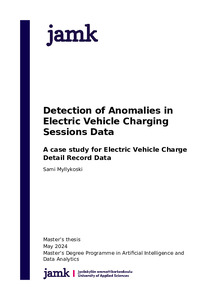Detection of Anomalies in Electric Vehicle Charging Sessions Data
Myllykoski, Sami (2024)
Myllykoski, Sami
2024
All rights reserved. This publication is copyrighted. You may download, display and print it for Your own personal use. Commercial use is prohibited.
Julkaisun pysyvä osoite on
https://urn.fi/URN:NBN:fi:amk-2024052716601
https://urn.fi/URN:NBN:fi:amk-2024052716601
Tiivistelmä
Anomalies, or outliers, in data are deviations from expected patterns and can result from errors, rare events, system glitches, or fraudulent activities. Understanding anomalies is crucial across industries, as they can signal fraud, malfunctions, or unforeseen events. This research study explores various anomaly detection techniques, from supervised to unsupervised learning methods, to enhance data analysis skills across domains.
The study categorizes different techniques into subgroups based on their underlying approaches, aiming to offer a structured overview. It focuses on anomaly detection in data, anticipating to enhance methodological understanding and demonstrate cross domain applicability.
Anomaly detection is a notable problem investigated across numerous research domains and application fields. While some techniques are tailored for specific application domains, others are more generalized. The study seeks to offer a thorough understanding of the techniques landscape in anomaly detection in Electric Vehicle Charging Sessions Data.
The study enhance understanding of the various methological directions within anomaly detection and clustering. It illustrates what techniques was developed in one domain can be deployed to other domains where it was not initially intended.
The evaluation metrics for classification models have achieved an accuracy of over 99% with binary classification algorithms. This high accuracy rate is encouraging and presents a significant potential to automate anomaly detection in production systems. This automation can help mitigate business risks substantially.
The study categorizes different techniques into subgroups based on their underlying approaches, aiming to offer a structured overview. It focuses on anomaly detection in data, anticipating to enhance methodological understanding and demonstrate cross domain applicability.
Anomaly detection is a notable problem investigated across numerous research domains and application fields. While some techniques are tailored for specific application domains, others are more generalized. The study seeks to offer a thorough understanding of the techniques landscape in anomaly detection in Electric Vehicle Charging Sessions Data.
The study enhance understanding of the various methological directions within anomaly detection and clustering. It illustrates what techniques was developed in one domain can be deployed to other domains where it was not initially intended.
The evaluation metrics for classification models have achieved an accuracy of over 99% with binary classification algorithms. This high accuracy rate is encouraging and presents a significant potential to automate anomaly detection in production systems. This automation can help mitigate business risks substantially.
